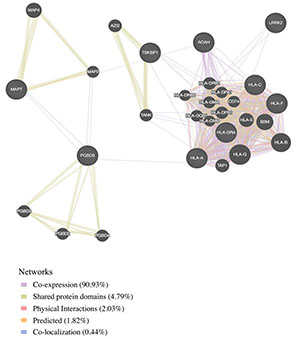Establishing a Link Between Frontotemporal Dementia (FTD) and Immune Dysfunction
Researchers from UC San Francisco have discovered a new link between frontotemporal dementia (FTD) and immune dysfunction. Their study, Immune-related genetic enrichment in frontotemporal dementia: An analysis of genome-wide association studies, was published in the January 2018 edition of PLOS Medicine and represents the single largest FTD genetics study to date.
 The research, led by a team from UCSF’s Neuroradiology Section in collaboration with colleagues in the UCSF Memory and Aging Center and 15 other university medical departments and research centers from around the world, uncovers genetic signals shared between patients with FTD and those with a variety of immune-mediated disorders. This genetic overlap is concentrated within the HLA region on Chromosome 6, an area rich in genes important for the function of microglia – the brain’s resident immune cells. The results suggest that for a subset of FTD patients immune dysfunction may contribute to disease risk and holds promise for future clinical trials targeting immune dysfunction in patients with FTD.
The research, led by a team from UCSF’s Neuroradiology Section in collaboration with colleagues in the UCSF Memory and Aging Center and 15 other university medical departments and research centers from around the world, uncovers genetic signals shared between patients with FTD and those with a variety of immune-mediated disorders. This genetic overlap is concentrated within the HLA region on Chromosome 6, an area rich in genes important for the function of microglia – the brain’s resident immune cells. The results suggest that for a subset of FTD patients immune dysfunction may contribute to disease risk and holds promise for future clinical trials targeting immune dysfunction in patients with FTD.
To reach their conclusion, the researchers used data from large genome-wide association studies (totaling 192,886 cases and controls) and recently developed statistical tools to explore genetic overlap/pleiotropy between different diseases. Through this approach they identified numerous locations in the genome (known as single nucleotide polymorphisms or ‘SNPs’) that are jointly associated with both FTD and one or more immune-mediated diseases, including Crohn’s disease, ulcerative colitis, rheumatoid arthritis, type 1 diabetes, celiac disease, and psoriasis. These SNPs implicate a novel set of genes in the pathogenesis of FTD; genes that the researchers show are overexpressed in the brains of patients with FTD compared to controls, and in microglia compared to other cell types within the brain.
As its name suggests, the FTD disease process results in progressive damage to the frontal and/or temporal lobes of the brain. Two important factors distinguish FTD from the more familiar type of dementia associated with Alzheimer’s disease (AD). First, patients with FTD experience progressive decline and disruption in cognitive domains including executive function, personality, or language, often with relative preservation of memory. This means that in the early stages of the disease some FTD patients may be misdiagnosed as suffering from a psychiatric disorder. Second, FTD is seen in much younger patients than AD, with most cases occuring in patients in their 50s and 60s, making FTD the leading cause of dementia in those younger than 65.
There are currently no treatments to slow or stop the progression of FTD and no diagnostic tests to predict its onset or measure its progression. However, as this study demonstrates, FTD research is making progress — helping clinicians better understand the disorder and suggesting promising new avenues for diagnosis and treatment. This study suggests that one important direction for this future work will be the development of methods for imaging and treating immune dysfunction in the brains of patients with FTD.
UCSF researchers who participated in this cutting-edge study include Iris Broce, Christopher P. Hess, William P. Dillon, Chin Hong Tan, Zachary A. Miller, Luke W. Bonham, Gil D. Rabinovici, Howard J. Rosen, Jennifer S. Yokoyama, Bruce L. Miller, Rahul S. Desikan and Leo P. Sugrue.
For more information, please click here to see the full study.
